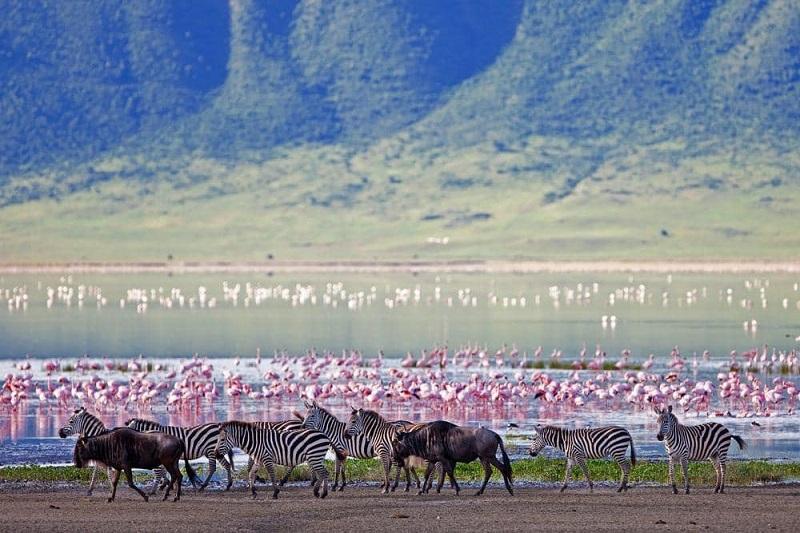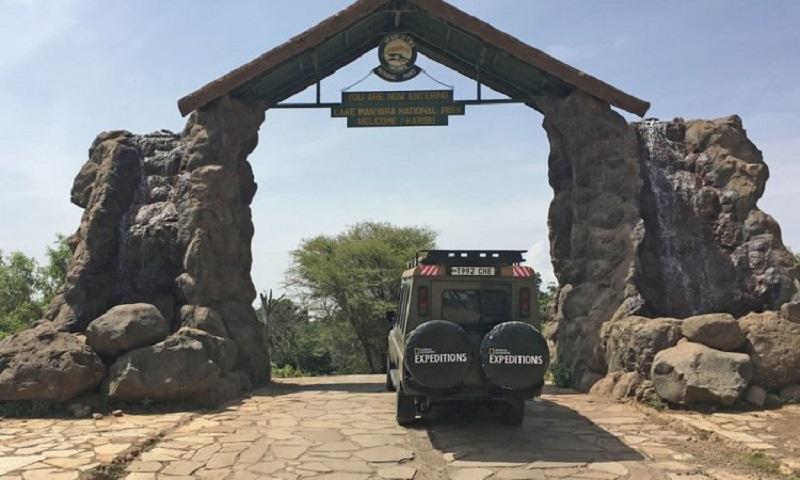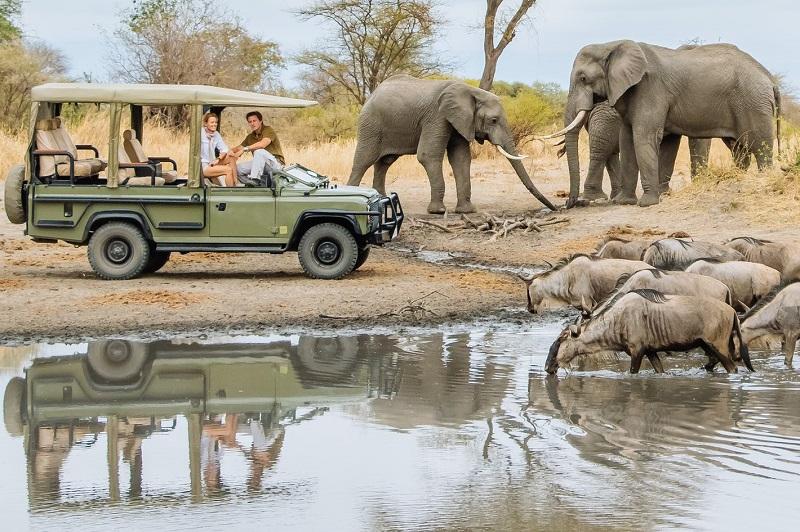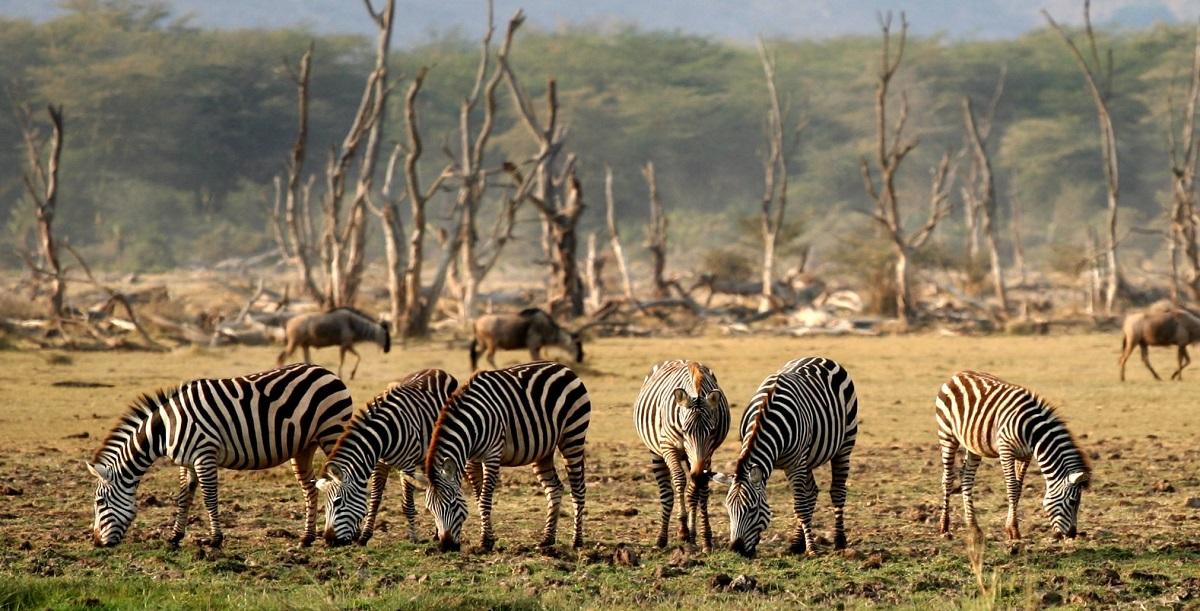Nestled at the base of the Great Rift Valley, Lake Manyara National Park is one of Tanzania’s smaller yet incredibly diverse parks. Established in 1960, it covers about 330 square kilometers, with about two-thirds of the park occupied by the shallow alkaline lake.
Though not as large as other Tanzanian parks, it offers an immersive experience with its blend of dense forests, acacia woodlands, and expansive grassy plains. Lake Manyara is famous for its tree-climbing lions, large flocks of flamingos, and varied wildlife, making it a top destination for nature lovers and wildlife enthusiasts.
Whether you’re looking to enjoy the scenic beauty or indulge in wildlife spotting, the park’s ecological variety ensures there is something for everyone to appreciate.
Please Download Our Mobile App here
Overview of Lake Manyara National Park
Lake Manyara National Park lies about 126 kilometers west of Arusha and is a part of the northern safari circuit. This makes it a convenient stop for tourists traveling to the Serengeti or Ngorongoro Crater. The park offers striking geographical contrasts, starting from the lush groundwater forest fed by underground springs at the entrance to the expansive, soda-rich lake in the heart of the park.
The diverse habitats within the park support a wide range of wildlife and bird species, making it a UNESCO-designated biosphere reserve. Aside from its famed tree-climbing lions, the park is also home to large elephant herds, hippos, giraffes, and more than 400 species of birds.
Whether you’re embarking on a guided game drive, walking safari, or canoeing along the lake, Lake Manyara offers rich opportunities for wildlife encounters amid its diverse landscape.
Wildlife in Lake Manyara National Park

Lake Manyara National Park is a wildlife haven, especially for those fascinated by birds. The lake’s alkaline waters attract thousands of flamingos during the wet season, forming pink clouds across the lake, while other bird species, such as pelicans, storks, and herons, thrive along the shorelines.
The park is also famous for its unusual tree-climbing lions, a rare behavior for the species, which visitors may be lucky enough to witness. The forested areas are home to large elephant herds, which can be spotted frequently along the park’s paths, as well as baboons, warthogs, and blue monkeys.
The open plains and woodland areas are perfect for viewing herbivores such as zebras, wildebeest, giraffes, and buffaloes. Additionally, the hippo pool at the lake’s edge offers a unique vantage point for watching these semi-aquatic giants. The diversity of wildlife at Lake Manyara makes it a must-see for anyone visiting Tanzania.
Best Time to Visit Lake Manyara National Park
The best time to visit Lake Manyara National Park depends on your specific interests. For wildlife viewing, the dry season from June to October is ideal, as the animals tend to congregate around water sources, making them easier to spot.
The lack of rain also ensures that roads are in good condition, making it easier to navigate through the park. For birdwatching enthusiasts, the wet season from November to April is a prime time to visit. During this period, the lake swells, attracting migratory birds, including large flocks of flamingos.
The park’s vegetation also becomes lush and green, providing a striking contrast to the dry landscape. Though the rains can make some roads muddy and inaccessible, the park remains open year-round, and the increased bird activity in the wet season makes it a rewarding experience for birdwatchers.
Getting to Lake Manyara National Park

Lake Manyara National Park is easily accessible from the city of Arusha, which is about 126 kilometers away—a drive of roughly two hours. Most visitors traveling to the northern circuit use Arusha as their starting point.
The park can be accessed via the main entrance, located near the town of Mto wa Mbu. Several tour operators offer guided safaris to Lake Manyara as part of a larger tour package that often includes visits to the Serengeti, Tarangire, or Ngorongoro Crater.
For those who prefer to fly, there are scheduled flights to Manyara airstrip, located just outside the park, which can be arranged from Arusha or Kilimanjaro International Airport. Once at the park, game drives are the primary way to explore the area, but walking safaris and cultural tours in nearby villages offer alternative ways to experience the surroundings.
Other Activities in Lake Manyara National Park
Visitors to Lake Manyara National Park have a variety of activities to choose from, ensuring a well-rounded experience. Game drives are the primary attraction, with early morning and late afternoon being the best times to spot wildlife. The park also offers unique experiences such as canoeing on the lake (when water levels permit), providing a different perspective on the park’s wildlife and landscape.
Birdwatching is another popular activity, especially during the wet season, as the park becomes a birdwatcher’s paradise with more than 400 recorded species. Walking safaris, led by experienced guides, offer an up-close and personal encounter with the park’s flora and smaller fauna.
Night drives, available with special permits, give visitors the chance to spot nocturnal animals such as porcupines, bush babies, and perhaps even lions on the hunt. Lastly, cultural tours to nearby villages like Mto wa Mbu give visitors insight into the local Maasai and Barabaig cultures, adding a cultural dimension to the wildlife adventure.
Park Fees at Lake Manyara National Park

Entry fees for Lake Manyara National Park vary depending on nationality. For non-residents, the entrance fee is roughly $45 for adults and $15 for children under 16. Residents of Tanzania typically pay reduced fees, around TZS 10,000 for adults.
You also have the option to pay additional fees for activities such as canoeing, night safaris, or guided walking tours. Fees may vary slightly depending on the tour operator and specific activities, so it’s always advisable to confirm current rates with your travel agent or directly with the Tanzania National Parks Authority before your visit.
FAQs
What animals are most common in Lake Manyara National Park?
Visitors can expect to see elephants, giraffes, zebras, hippos, tree-climbing lions, and large flocks of flamingos, especially around the lake area.
Are there any accommodations inside the park?
Yes, there are a few lodges and campsites both inside and near the park, ranging from luxury lodges to budget-friendly campsites.
Is it possible to visit Lake Manyara on a day trip?
Yes, due to its proximity to Arusha, Lake Manyara National Park is often visited as part of a day trip, although a longer stay allows for a more relaxed experience.
Conclusion
Lake Manyara National Park is a gem in Tanzania’s northern safari circuit, offering you a unique mix of scenic beauty, wildlife diversity, and varied activities. A visit to Lake Manyara provides a perfect balance between exploration, wildlife viewing, and cultural experiences, making it a must-see destination for anyone exploring Tanzania.



